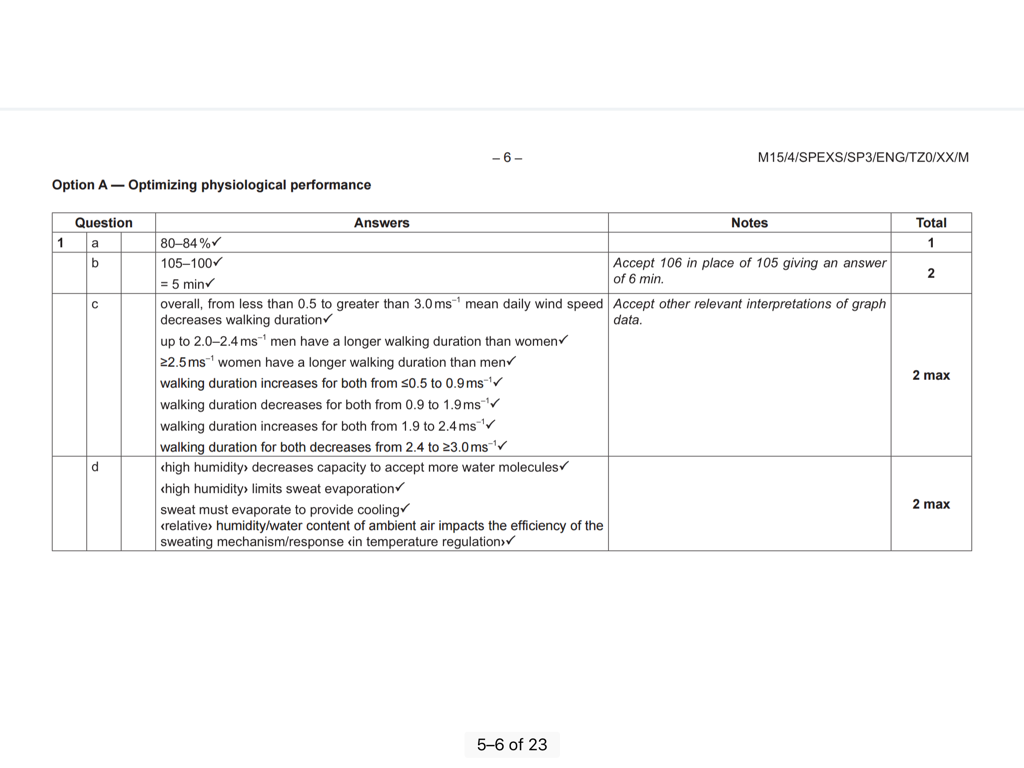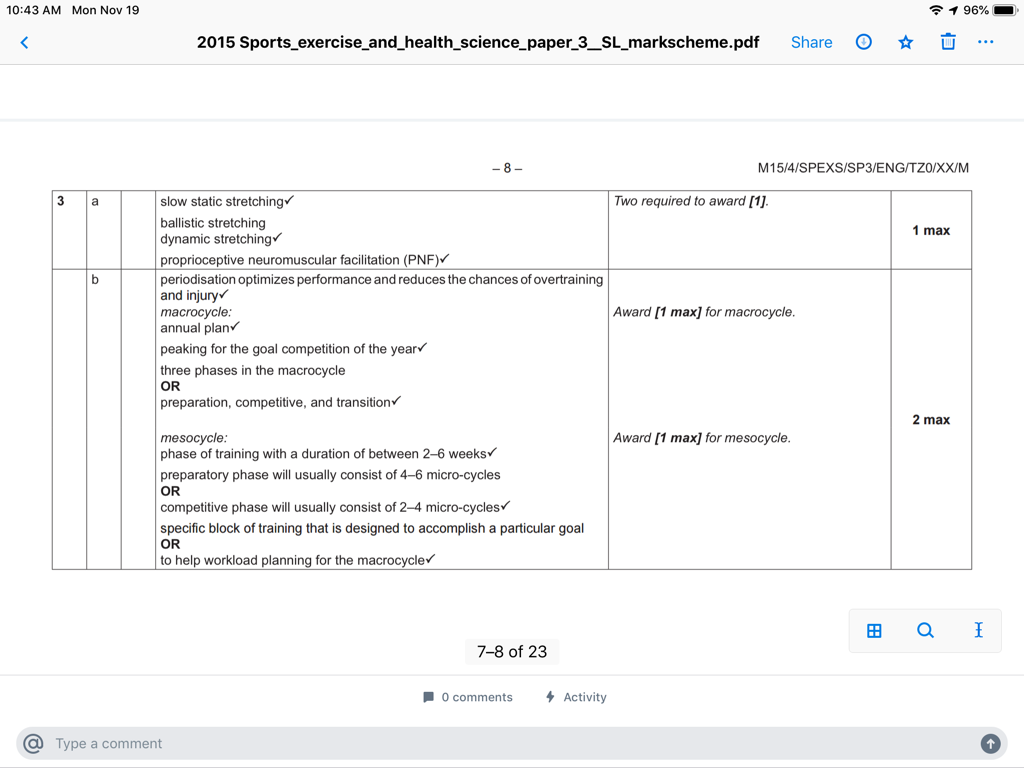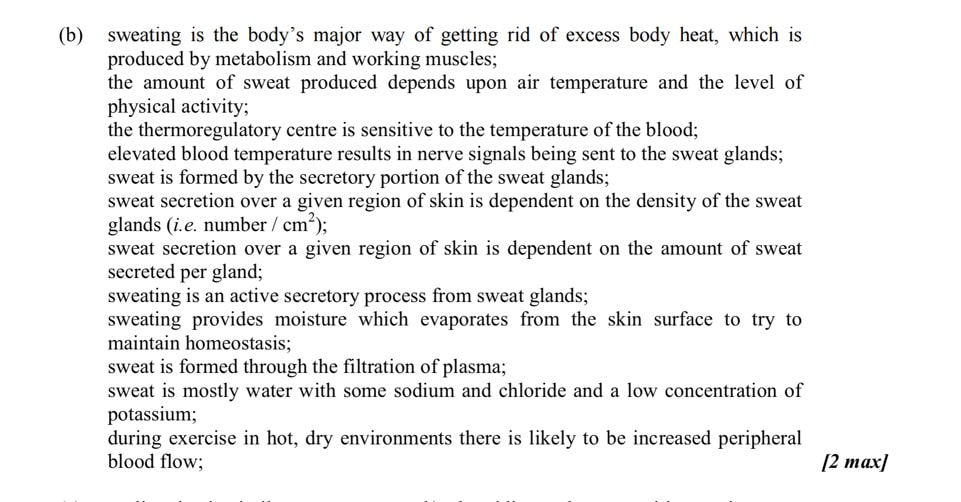GoMLC
A1 - Training
A.1.1 Distinguish between training and overtraining.
A.1.2 Describe various methods of training:
- Flexibility Training, Strength and Resistance Training, Circuit Training, Interval Training, Plyometrics, Continuous Training, Fartlek Training, Cross Training
A.1.3 Discuss possible indicators of overtraining.
A.1.4 Discuss how periodisation should be organised to optimize performance and avoid overtraining.
A.1.2 Describe various methods of training:
- Flexibility Training, Strength and Resistance Training, Circuit Training, Interval Training, Plyometrics, Continuous Training, Fartlek Training, Cross Training
A.1.3 Discuss possible indicators of overtraining.
A.1.4 Discuss how periodisation should be organised to optimize performance and avoid overtraining.
A1 Support
A.1.3 - Article on the important (read CRITICAL) need for rest in the quest for GAINS!
The files below are helpful for SENIOR YEAR SUMMER WORK in section A1
|
|
|
Paper 3 Markscheme for the A1 review.
A2 - Environmental Factors and Physical Performance
A.2.1 Explain the relationship between cellular metabolism and the production of heat in the human body
A.2.2 State the normal physiological range for core body temperature.
A.2.3 Outline how the body thermoregulates in hot and cold environments. (***use this link for Summer Work***)
A.2.4 Discuss the significance of humidity and wind in relation to body heat.
A.2.5 Describe the formation of sweat and the sweat response.
A.2.6 Discuss the physiological responses that occur during prolonged exercise in the heat.
A.2.7 Discuss the health risks associated with exercising in the heat.
A.2.8 Outline what steps should be taken to prevent and to subsequently treat heat-related disorders.
A.2.9 Describe how an athlete should acclimatize to heat stress.
A.2.10 Discuss the physiological adaptations that occur with heat acclimatization.
A.2.11 Outline the principal means by which the body maintains core temperature in cold environments.
A.2.12 Explain why the body surface area-to-body mass ratio is important in terms of heat preservation.
A.2.13 Outline the importance of wind-chill in relation to body heat loss.
A.2.14 Explain why swimming in cold water represents a particular challenge to the body’s ability to thermoregulate.
A.2.15 Discuss the physiological responses to exercising in the cold.
A.2.16 Describe the health risks of exercising in the cold, including cold water.
A.2.17 Discuss the precautions that should be taken when exercising in the cold.
A.2.2 State the normal physiological range for core body temperature.
A.2.3 Outline how the body thermoregulates in hot and cold environments. (***use this link for Summer Work***)
A.2.4 Discuss the significance of humidity and wind in relation to body heat.
A.2.5 Describe the formation of sweat and the sweat response.
A.2.6 Discuss the physiological responses that occur during prolonged exercise in the heat.
A.2.7 Discuss the health risks associated with exercising in the heat.
A.2.8 Outline what steps should be taken to prevent and to subsequently treat heat-related disorders.
A.2.9 Describe how an athlete should acclimatize to heat stress.
A.2.10 Discuss the physiological adaptations that occur with heat acclimatization.
A.2.11 Outline the principal means by which the body maintains core temperature in cold environments.
A.2.12 Explain why the body surface area-to-body mass ratio is important in terms of heat preservation.
A.2.13 Outline the importance of wind-chill in relation to body heat loss.
A.2.14 Explain why swimming in cold water represents a particular challenge to the body’s ability to thermoregulate.
A.2.15 Discuss the physiological responses to exercising in the cold.
A.2.16 Describe the health risks of exercising in the cold, including cold water.
A.2.17 Discuss the precautions that should be taken when exercising in the cold.
Your browser does not support viewing this document. Click here to download the document.
Your browser does not support viewing this document. Click here to download the document.
TOK Thinking
How is the ability to tolerate harsh environmental conditions affected for people who habitually live in
very cold or hot climates?
- What are the costs associated with the acclimatization of athletes using environmental chambers and/or
expensive overseas training facilities?
- What are the ethical implications for the wealthier nations in being able to afford the acclimatization of athletes?
A.2.5 Describe the formation......
A.2.5 Outline how the evaporation.....
A.2.7
| lost_in_the_desert_case_study.pdf | |
| File Size: | 229 kb |
| File Type: | |
A3 - Non-Nutritional Ergogenic Aids
A.3.1 Define the term ergogenic aid.
A.3.2 Describe with reference to an appropriate example, the placebo effect.(watch video)
A.3.3 List five classes of non-nutritional ergogenic aids that are currently banned by the International Olympic Committee (IOC) and World Anti-Doping Agency (WADA). (Anabolic steroids, hormones and related substances, diuretics and masking agents, beta blockers and stimulants).
A.3.4 Discuss why pharmacological substances appear on the list of banned substances.
A.3.5 Discuss the proposed and actual benefits that some athletes would hope to gain by using anabolic steroids, erythropoietin (EPO), beta blockers, caffeine and diuretics.
A.3.6 Outline the possible harmful effects of long term use of anabolic steroids, EPO, beta blockers, caffeine and diuretics.
A.3.2 Describe with reference to an appropriate example, the placebo effect.(watch video)
A.3.3 List five classes of non-nutritional ergogenic aids that are currently banned by the International Olympic Committee (IOC) and World Anti-Doping Agency (WADA). (Anabolic steroids, hormones and related substances, diuretics and masking agents, beta blockers and stimulants).
A.3.4 Discuss why pharmacological substances appear on the list of banned substances.
A.3.5 Discuss the proposed and actual benefits that some athletes would hope to gain by using anabolic steroids, erythropoietin (EPO), beta blockers, caffeine and diuretics.
A.3.6 Outline the possible harmful effects of long term use of anabolic steroids, EPO, beta blockers, caffeine and diuretics.
Your browser does not support viewing this document. Click here to download the document.
Your browser does not support viewing this document. Click here to download the document.
TOK Thinking...
- What are the effects, both ergogenic and harmful, of many banned substances?
- What are the ethical issues about studying these agents in otherwise healthy individuals in randomized controlled trials?
- What constitutes an acceptable level of risk of non-nutritional ergogenic aid use?




